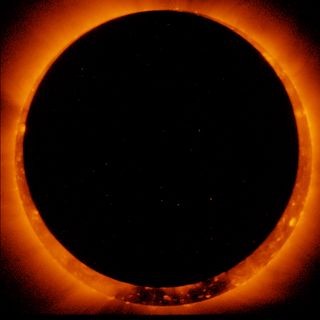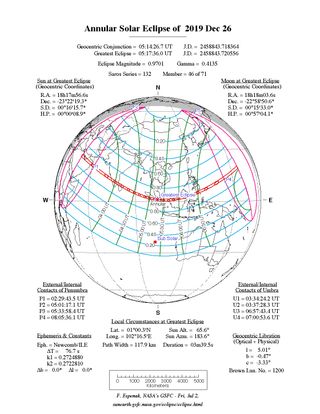
If you're planning to spend Christmas in the Eastern Hemisphere, you'll have a celestial treat to look forward to the next day as the new moon eclipses the sun in an annular event, or "ring of fire" solar eclipse, on Wednesday (Dec. 26).
This will be the final eclipse of 2019 and unfortunately, North America will not see any part of it. Only skywatchers in parts of Europe, Asia, Australia and Africa will be able to catch a glimpse of the display. (Warning: Be sure to track down proper eye protection if you live in these areas! It is dangerous to view the sun directly during all stages of this eclipse.)
You can watch the "ring of fire" solar eclipse online, courtesy of Slooh.com, beginning at 10 p.m. EST on Dec. 24 (0300 Dec. 26 GMT). The webcast will be available directly from Slooh.com here, and on the Space.com homepage.
Related: Amazing Solar Eclipse Pictures from Around the World
Although the new moon will pass directly across the face of the sun, it will not cover the sun's face entirely. That's because the moon is currently farther than average from the Earth, so its apparent size is 3% smaller than that of the sun.
The moon reached its perigee point, the point in its orbit when it is closest to Earth, on Dec. 18. But that was its most distant perigee of the year. At that time, it was 230,000 miles (370,300 kilometers) away from skywatchers. But when the eclipse rolls around, the moon will have receded to a distance of 238,700 miles (384,200 km) from Earth.

That distance means that the tip of the moon's cone of darkest shadow, called the umbra, will miss reaching Earth's surface. As a consequence, the moon will not be able to completely cover the sun and produce the grand spectacle of a total solar eclipse.
Instead, a "negative shadow" called the antumbra will produce a ring of fierce sunlight or a "ring of fire" that shines around the dark silhouette of the moon. The result is an annular eclipse, the name of which is derived from the Latin annulus, meaning "ring-shaped."
Get the Space.com Newsletter
Breaking space news, the latest updates on rocket launches, skywatching events and more!
For an analogy, place a penny on top of a nickel. The penny represents the moon and the nickel represents the sun; a ring of silver remains visible around the penny's edge.
Sight for the millions
Unlike July's eclipse of the sun, during which the path of totality swept mostly over the open ocean, this eclipse will be visible from many heavily populated areas. Its path averages 88 miles (142 km) wide in a swath stretching from the Middle East to the western Pacific Ocean.
Skywatchers will be able to see the annular eclipse from locations including Saudi Arabia, Bahrain, Qatar, United Arab Emirates, Oman, India, Sri Lanka, Sumatra, Singapore, Borneo, the Philippines, and even the tiny U.S. territory of Guam.
The ring of sunlight will last the longest just east of the Indonesian island of Pulau Gin Besar, where the eclipse will glow for 3 minutes and 39.5 seconds.
Skywatchers in virtually all of Asia, northeastern Africa and the northern and western portions of Australia will be able to catch a partial eclipse. Local eclipse times for a number of cities in Asia are available online here courtesy of astronomer Fred Espenak. All times are local; the sun's altitude and azimuth, eclipse magnitude and eclipse obscuration are all given at the instant of maximum eclipse.
Coming attractions
Looking ahead to 2020, another annular eclipse will sweep across Africa, Arabia, Asia and the Pacific on June 21. But because the moon will be closer to the Earth than during our upcoming eclipse, the ring of sunlight will be much thinner. The dark disk of the moon will appear to be only 0.6% smaller than that of the sun. In some regions, the annular eclipse will last just 38 seconds.
Then, on Dec. 14, a total solar eclipse will cross the South Pacific and parts of Chile and Argentina before passing over the South Atlantic. The maximum duration of totality will be 2 minutes and 10 seconds.
U.S. skywatchers will miss out on both of these events. North America isn't due for a solar eclipse until Oct. 14, 2023's annular spectacle. A total eclipse will follow less than six months later, on April 8, 2024.
Texan skywatchers will be particularly lucky, as the tracks of both of these eclipses cross the state. But both of these eclipses in their partial form will be widely visible across much of North America.
Editor's note: If you capture a stunning view of the Dec. 26 "ring of fire" solar eclipse and would like to share it with Space.com and our news partners for a possible story or gallery, send images to Editor in Chief Tariq Malik at tmalik@space.com and spacephotos@space.com.
- Photos: Annular Solar Eclipse of May 20, 2012
- Solar Eclipse Guide 2019: When, Where & How to See Them
- Solar Eclipse Photography: Tips, Settings, Equipment and Photo Guide
Joe Rao serves as an instructor and guest lecturer at New York's Hayden Planetarium. He writes about astronomy for Natural History magazine, the Farmers' Almanac and other publications. Follow us on Twitter @Spacedotcom and on Facebook.

Join our Space Forums to keep talking space on the latest missions, night sky and more! And if you have a news tip, correction or comment, let us know at: community@space.com.

Joe Rao is Space.com's skywatching columnist, as well as a veteran meteorologist and eclipse chaser who also serves as an instructor and guest lecturer at New York's Hayden Planetarium. He writes about astronomy for Natural History magazine, the Farmers' Almanac and other publications. Joe is an 8-time Emmy-nominated meteorologist who served the Putnam Valley region of New York for over 21 years. You can find him on Twitter and YouTube tracking lunar and solar eclipses, meteor showers and more. To find out Joe's latest project, visit him on Twitter.
-
Mugilu.in Guys,Reply
I put together this video with all the information about the upcoming solar eclipse. Hope you find it useful.
X6WNWispnSAView: https://www.youtube.com/watch?v=X6WNWispnSA
